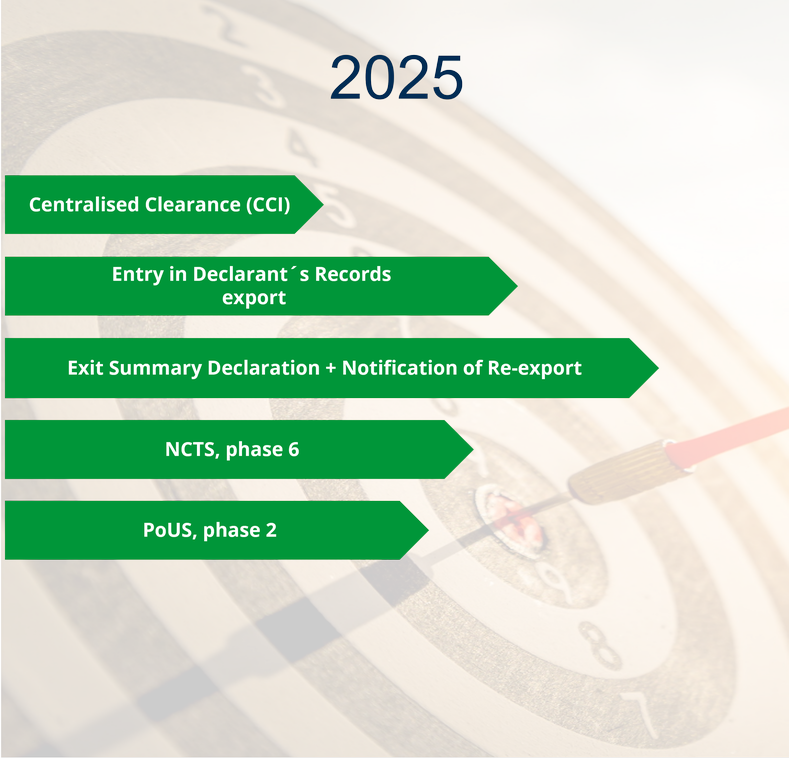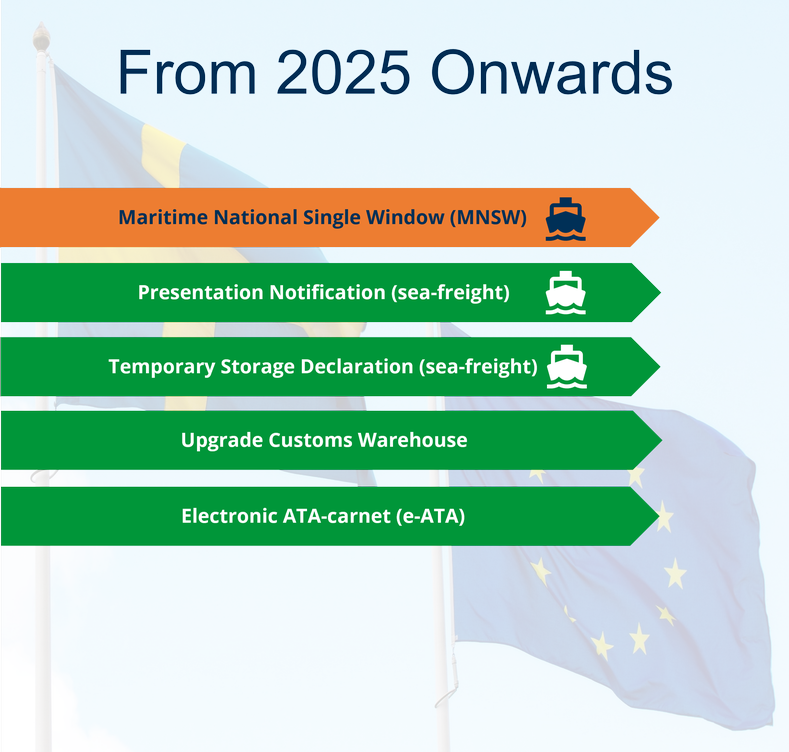
Future customs procedures
Schedule for introduction of the Union Customs Code
The Union Customs Code is being introduced in stages.You can follow the work on this page. Swedish Customs’ national schedule will be updated as work progresses, and we will be publishing dates of relevance for the introduction of, and migration to, new systems.
2025
 Zoom image
Zoom imageClick on the image to enlarge.
Entry summary declaration, ICS2 Release 3, for transport by sea, road and rail
The third release of ICS2 will be introduced in 3 steps:
- Maritime carriers, 3 June - 4 December 2024.
- House filers, 4 December 2024 –1 April 2025.
- ICS2, Release 3, for road and rail transport will be introduced between 1 April - 1 September 2025.
Traffic from Norway and Switzerland will still be exempt from the requirement to file a presentation notification or summary declaration, as Norway and Switzerland are part of the Security Zone.
Centralised customs clearance, import (standard customs declaration)
Central customs clearance will allow economic operators to submit customs declarations in a Member State, regardless of where the goods enter the EU. This means, among other things, that when the procedure starts, data contained in the customs declarations will be exchanged digitally in real time between the Member States concerned. A centralised IT support to facilitate this exchange of information has been developed by the European Commission; however, this requires the integration and adaptation of the national IT systems for import, as well as adaptations of existing procedures.
Centralised customs clearance will be implemented in two phases. The first phase includes, among other things, standard customs declarations. The second phase includes, for example, simplified and supplementary declarations and entry in the declarant's records. Centralised clearance for standard customs declarations will go live in Sweden on 2 June 2025. As for phase 2, we plan for this to be introduced in Sweden on 1 September 2026.
Entry in the declarant's records (EIDR), export
Entry in the declarant's records (EIDR) to be implemented autumn 2025.
The level of details in these records must correspond with the requirements for a simplified declaration. There will also be a requirement to notify Swedish Customs whenever an entry is made in the declarant’s records.
Exit summary declaration and re-export notification
An online service is being developed for cases where an export declaration is not to be submitted and you instead need to submit a separate exit summary declaration.
An online service is also being developed for re-export notifications, for example for goods that are in temporary storage and must be notified for re-export.
NCTS , Release 6
Release 6 of the NCTS is a further development of Release 5, whereby the customs authorities will be able to decide to receive safety and security information in the New Computerised Transit System (NCTS). In Sweden, Swedish Customs has decided that security and safety information will be provided in the import control system, ICS2, that is, not in the transit system.
The introduction of Release 6 of the NCTS will take place between March and September 2025.
Proof of Union Status
Phase 2 of the PoUS system concerns customs goods manifests. It is a central system and is planned to be introduced at the same time as the European Maritime Single Window (EMSW) in August 2025, but as the national parts in the form of the Maritime National Single Window (MNSW) will be delayed, an analysis is underway at EU level of what this means for phase 2 of the PoUS system. If you, as an accredited certificate provider, use ship's manifests as proof of Union status, you can continue to use the manifest according to the current model until phase 2 of PoUS goes live.
 Zoom image
Zoom imageClick on the image to enlarge
Maritime National Single Window (MNSW)
The Maritime National Single Window (MNSW) introduces the national elements of the European Maritime Single Window (EMSW), which will enable all ship reporting to be done to one contact point per Member State. The Swedish Maritime Administration is responsible for this point of contact. It will be possible to submit required for customs purposes, i.e., notification of arrival of goods and temporary storage, using this single point of contact.The Swedish Environmental Protection Agency is the competent authority in Sweden.
The implementation in Sweden is scheduled for Q1, 2027. The MNSW will then replace the Maritime Single Window (MSW), the current system. According to the previous schedule, the implementation would take place on 15 August 2025. The impact of this change in the timetable on customs formalities in the form of presentation notifications and temporary storage in the maritime flow is being analysed. For the time being, the existing transitional solution is used.
Customs warehouse upgrade
Our system for customs warehouses, implemented in 2016, needs to be upgraded to fully comply with the Union Customs Code. This upgrade is currently being analysed.
Electronic ATA carnets (e-ATA)
ATA carnets are based on two international conventions (the ATA Convention and Annex A of the Istanbul Convention) which make it possible to simplify customs formalities in connection with the temporary entry and exit of goods in different countries. In Sweden, ATA carnets are issued by the Swedish Chamber of Commerce, with the Stockholm Chamber of Commerce as the national guaranteeing organisation.
The International Chamber of Commerce (ICC) has developed a digital system to replace the current paper-based system. EU Member States will join the system from 2025. It has not been decided when Sweden will join. Paper carnets will continue to exist in parallel during a transitional period until all contracting parties worldwide have joined. In some cases, both paper and electronic versions will therefore be necessary.
Additional information
Here you will find information needed for system developers that are developing a customs EDI-system or companies developing an in-house system.
Last updated:
What is updated: Quality assured
